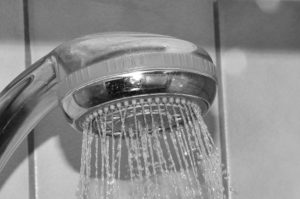by Bill Gauley and John Koeller
Did you know that, on average, people take 0.69 showers per day? Did you know that the average shower lasts 7.8 minutes? Did you know that showering uses a lot of water? Showering currently accounts for almost 20% of all indoor residential water demand!
There is no question that many people want to be environmentally responsible and use our natural resources—including water—more efficiently. But do low-flow showerheads actually save water? Or do lower flow rates simply mean people take longer showers—thus negating any potential water savings?
To answer this question, Bill Gauley and John Koeller analyzed data for more than 50,000 shower events1! Shower volumes were determined by multiplying the flow rate by the duration. The results were very clear (see Figure 1).
- People do not significantly compensate for lower flow rates by increasing the length of their shower. For every 0.2 gallon per minute (gpm) decrease in flow rate, shower duration only increased by about five seconds.
- Lower flow showerheads do result in a lower overall shower volume. For every 0.2 gpm decrease in flow rate, shower volume decreased by 1.34 gallons.
In fact, it seems that people tend to follow their own routine for showering regardless of the flow rate of the showerhead (at least for those showers between flow rates of 1.0 to 4.0 gpm). For example, if you take an eight-minute shower with a flow rate of 2.5 gpm (the current federal standard), then you are likely to take an eight-minute, 12-second shower with a flow rate of 2.0 gpm (the current U.S. EPA WaterSense® standard). But the total water used during your shower will decline from 20.0 gallons to only about 16.4 gallons!
While studies have shown that people tend to prefer higher flow-rate showerheads2, the results of this analysis clearly show that water savings can be achieved by using lower flow-rate showerheads. As a result, water and energy utilities interested in achieving higher levels of water savings are rebating high-performance, low flow rate showerheads.
The complete report can be at http://bit.ly/low_flow_showerhead.
The authors can be reached for questions at Bill Gauley, P Eng., Principal, Gauley Associates Ltd., bill@gauley.ca and John Koeller, P.E., Principal, Koeller & Company, koeller@earthlink.net.
1Data from 1999 and 2016 Residential End Uses of Water Studies (REUS1999 and REUS2016) completed by Aquacraft, Inc. Data provided by Co-Principal Investigator, Peter Mayer, P.E.
2High-Efficiency Showerhead Performance Study, 2009, Gauley, Robinson, Elton. Report can be found at http://bit.ly/showerhead_performance
This article originally appeared in Home Energy magazine online at www.homeenergy.org on March 20, 2017. It is reprinted with permission.









Leave a Reply